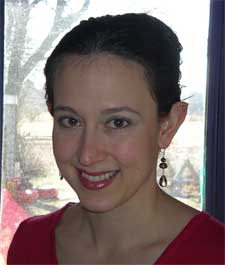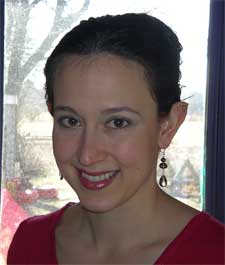 Nebraska native on home stretch of unique doctoral degree program
Nebraska native on home stretch of unique doctoral degree program
NARRAGANSETT, R.I. – May 10, 2010 — When archaeologists study the remains of underwater shipwrecks, they often disregard elements that Alicia Caporaso believes are vitally important to understanding the wreck site.
One of the first students in the University of Rhode Island’s graduate program in Archaeological Oceanography, Caporaso will earn her doctorate in August and will take with her an oceanographer’s perspective on examining marine archaeological sites.
“For most of the models that archaeologists use to study shipwreck sites, time zero is the shipwreck,” she explained. “Few of these models deal with why the ship was there in the first place, for example, did human behavior contribute to where it was found, or what about the physical system made it sink in that particular place. For archaeologists this is somewhat revolutionary. They tend to approach the archaeological site from the point that it settles in or on the seafloor, and they begin its study in that context.”
Caporaso’s dissertation proposes a new paradigm of how to conduct an analysis of underwater archaeological sites. She based her dissertation on research she conducted in Thunder Bay in northwest Lake Huron, where about 200 shipwrecks occurred between 1820 and 1950 due to collisions in fog, groundings on the treacherous lakeshore, and founderings for any number of other reasons.
She spent about one month a year from 2005 to 2008 aboard a ship collecting sidescan sonar data to create a complete image of the lake floor of the bay. Along the way she discovered two previously unknown wrecks.
“I was very interested in the movement of materials once the ship was wrecked,” said Caporaso, who has lived in Wakefield and West Warwick during her tenure at URI. “There were stretches of the lake floor that had absolutely nothing, so there is something about the physical system that prohibits wreckage from staying there. And then there were other areas where there were lots and lots of wreckage.”
A native of Omaha, Neb., who earned engineering and anthropology degrees from the University of Nebraska, Caporaso chose to obtain a Ph.D. in oceanography despite knowing that she would never become a traditional practicing oceanographer because she knew it would provide unique insight into the study of underwater archaeology.
“After finishing the oceanography program at URI, I know it would be difficult to get a true understanding of submerged archaeological sites without the oceanography background,” she said. “I see myself as a bridge between oceanographers and archaeologists. Now I can better understand data analyses, and I can approach a site, know what needs to be collected, and how to go about getting it.”
Professor Robert Ballard, the marine explorer who found the Titanic, launched the URI Archaeological Oceanography program in 2004. It is the first academic program of its kind to merge the disciplines of oceanography, ocean engineering, history, and archaeology.
If her URI coursework and dissertation research weren’t enough to keep her busy, Caporaso has also spent the last several years teaching undergraduate anthropology classes on such topics as frontier anthropology and the anthropology of religion. She also worked for the National Park Service assessing archaeological sites at Cape Cod National Seashore, the Gateway National Recreation Area, and the Vanderbilt Mansion National Historic Site, among others.
“If I hadn’t been doing all of that, I might have been able to finish my degree a year or so sooner,” she admitted.
With just a few months to go before graduation, Caporaso is actively seeking archaeology jobs in academia or for a government agency.
“It’s a little difficult to get a job in anthropology with an oceanography degree, but because I’ve been teaching anthropology here, it’s not out of the question,” she said. “To be successful, you have to take every opportunity that presents itself.”

